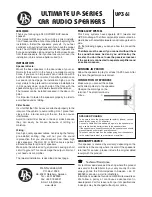
7 Dolby level versus operating level. Historical notes.
SDDS Print Master Guidelines, Page
20
of
26
7 Dolby level versus operating level.
Historical notes.
T he current standard for digital cinema sound has a headroom of 20dB above the
studio reference level. T his is usually 0VU in USA/France/Spain/I taly and 0dBu in the
UK. I f you look closely at a VU meter, 0VU is also marked as 100% . I t now seems
ludicrous that –20dB should be marked as 100% . However, when the meter was first
invented, it was decided, for safety that there would be at least 10dB of headroom
above this 0VU mark. T his is because the meter integrates the level over time and
gives an average reading. I t will miss instantaneous peaks. I t therefore tends to under
read, depending on program material. I n the film world the flux level of magnetic film
was set at 0VU= 185nWb/m. T his allows roughly 10dB of headroom, remembering that
maximum level on magnetic tape is not a strictly defined point, but that the onset of
saturation and distortion is gradual. T his reference level of 0VU then translated to an
SPL of 85dBc in the cinema. With the advent of digital recording there is no “onset of
tape saturation grey area” so it is even more important to have lots of headroom to
allow for instantaneous peaks. 20dBs was decided on, which seemed to suit the
instantaneous peaks found in film sound tracks.
I n the UK the film metering history is slightly different. Reference level practises tend
to come from the broadcast sector and the BBC in particular was a great setter of
standards. Here you are to find BBC PPM meters. Marked from 1 to 7, with the higher
numbers being 4dBs apart. PPM4 is usually 0dBu, PPM5, 0VU. T he reference level is
usually 0dBu, PPM4. T he maximum (broadcast) level is then PPM6, 8 dBs above
reference level. PPMs catch all the peaks so give a truer picture of the level. T ape flux
levels can be set much higher. 0dBu= 200nWb/m was the standard agreed on for
magnetic film. T hese meters are very convenient for mixing engineers – dialogue
peaks about 4 and music about 5 is a simple maxim.
When Dolby began their involvement with film sound and noise reduction in the 1970s,
they found a difference of 0.75dB between USA and UK. T his is accounted for by the
difference between 185nWb/m and 200nWb/m. T he simple remedy for this would have
been to change the flux level alignment of the mag machines, but in some cases the
electrical operating level was changed instead, with potentially confusing results.
I n a USA studio, operating level and “Dolby level” are always the same. But in
Germany still today, a situation exists where Dolby level is -4.75dB with respect to
operating level. T he reasons for this are purely historical and cause enormous
confusion. German broadcasting traditionally used the DI N system where the reference
level was the maximum broadcast level. T his was set for + 6dBu= 320nWb/m on
magnetic film and T ype 1 PPM meters were used. T o make a worldwide film, the
reference tone has to be 185nWb/m, which then equals 85dBc in the cinema. I t was
decided to keep the + 6dB= 320nWb/m standard and then record tone at –4.75dB with
respect to reference level, this equates to 185nWb/m. T his was then called “Dolby
Level”. T his all worked fine, but with the onset of digital cinema soundtracks, a bizarre
-4.75dB= -20dBfs scenario was produced and the reasons why are being lost. T o
counteract this, Dolby is now recommending that new studios follow the “American”
system of having the same Dolby level and reference level. T his makes sense as the
DI N maximum system has now largely disappeared in the film industry.







































